Troubleshoot Issues With the Windows Installer in Windows
The Windows Installer is a vital component of the Windows operating system that allows users to install and manage software applications on their computers. However, sometimes the Windows Installer can stop working, preventing users from installing or updating software.

One common cause of issues with the Windows Installer is corrupted or missing files related to the service. There are several system files that Windows Installer relies on to function properly, and if any of these files become damaged or disappear, the installer may not run or complete its tasks. This can happen due to a number of reasons, such as incomplete or unsuccessful installations, malware infections, or system crashes.
Other potential causes of problems with the Windows Installer include outdated or incompatible versions of the installer, conflicts with other programs or services running on the system, limited user account permissions, and pending Windows updates. Below, we have discussed several troubleshooting methods that you can try to fix the problem. Hopefully, they will help you resolve the issue for good in no time.
1. Make sure you have administrative privileges
If you’re encountering issues with the Windows Installer, it’s possible that you do not have the necessary privileges to carry out certain actions, which can result in failed installations or updates, error messages, or other issues. By ensuring that you have logged into an administrator account, you can potentially resolve these issues and allow the installer to function properly.
Here is how you can do that:
- Press the Win + I keys together to open the Settings app.
- Choose Accounts from the left pane.
- Navigate to Family & other users.
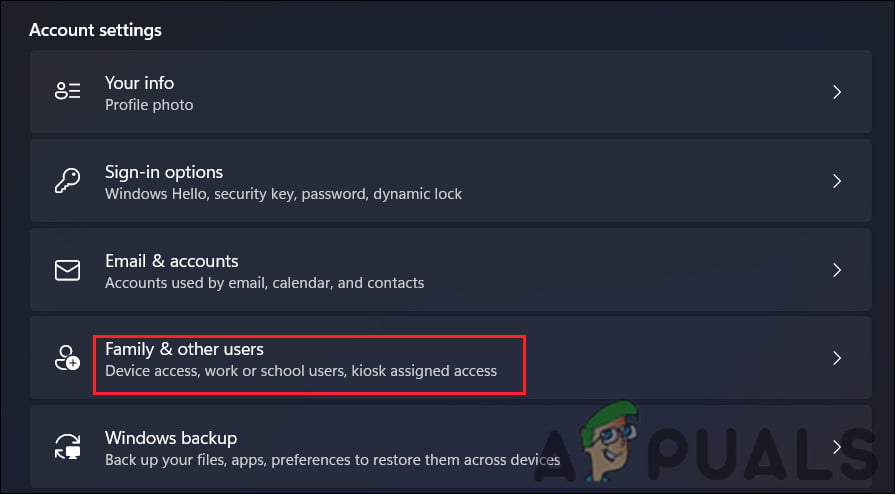
Navigate to Family & other users - Now, locate the account which is having problems with using the Windows Installer.
- Expand it and choose Change account type.

Change the account type - Expand the dropdown in the following dialog, and choose Administrator.

Set the account type to Administrator - Click OK to save the changes.
2. Ensure that the Windows Installer service is running
Windows Installer relies on relevant services to function properly. If the service is not running, the Windows Installer may not be able to carry out its tasks properly, which can result in failed installations or updates, error messages, or other issues.
By verifying that the Windows Installer service is running and starting it if necessary, you can potentially resolve these problems and get the installer working properly again.
Here is how you can do that:
- Press the Win + R keys together to open a Run dialog.
- Type services.msc in Run and click Enter.
- In the Services window, locate the Windows Installer Service and choose Properties from the context menu.
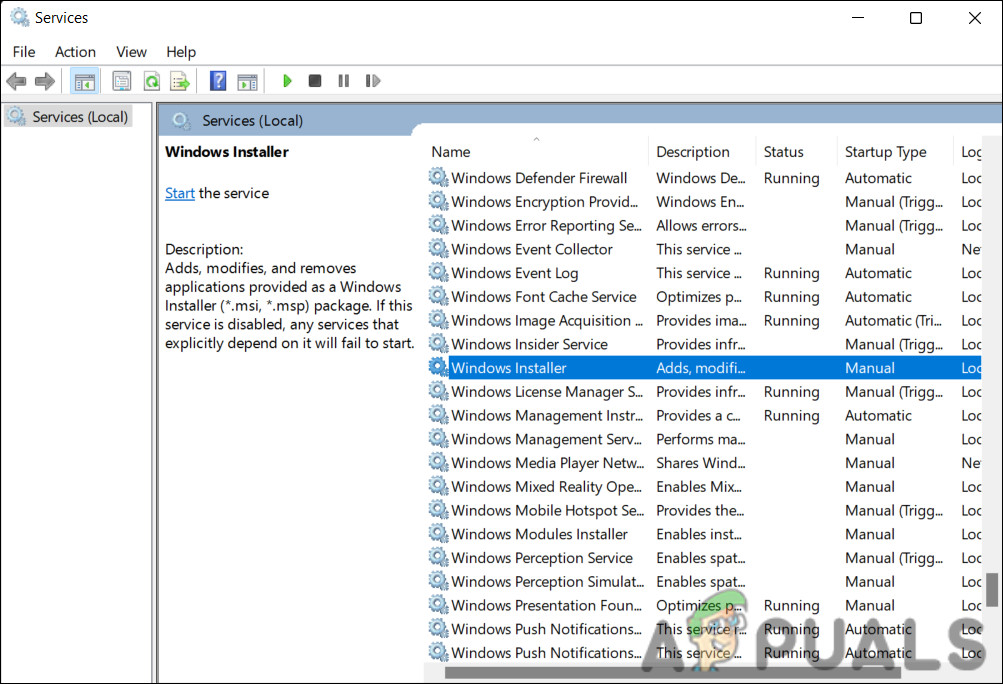
Access the service - Check if the service is running. If it is not, click on the Start button to start it.
- Make sure the Startup type is set to Automatic.
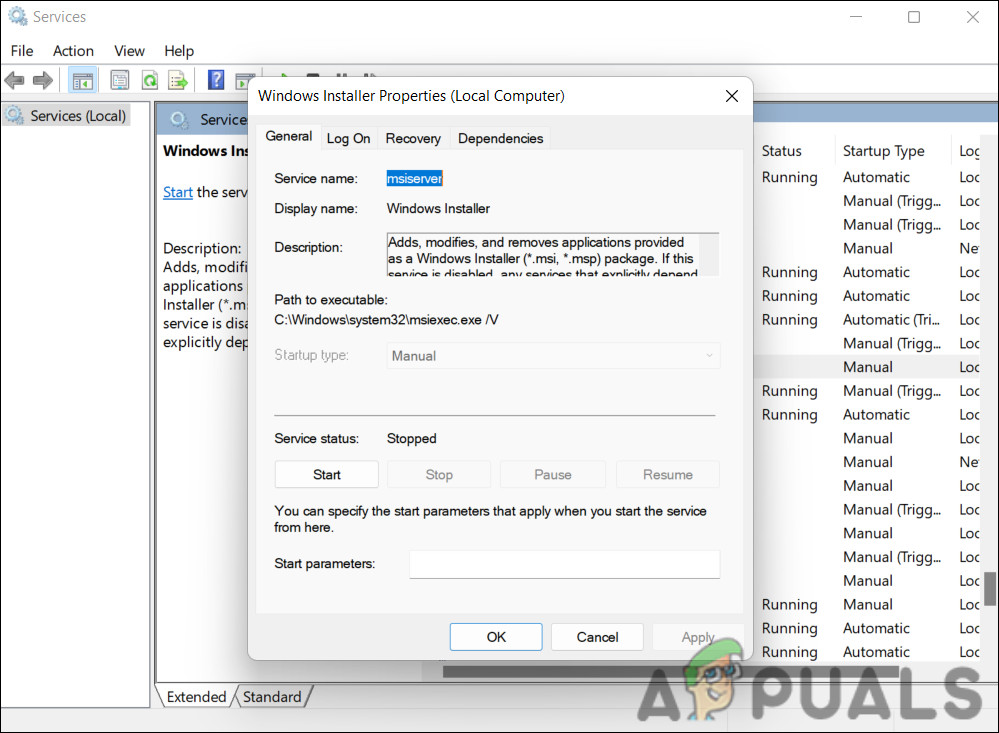
Click on the Start button - Click Apply > OK to save the changes.
Alternatively, you can also use the Task Manager utility to start this service. Here is how you can do that:
- Type Task Manager in the search area of the taskbar and click Open.
- Head over to the Services tab in the following window.
- Locate the msiserver service and right-click on it.
- Choose Start.

Start the service
You can close the Task Manager now and check if the issue is resolved.
3. Repair the Master Boot Record (MBR)
Since the Master Boot Record (MBR) is a critical part of the system boot process, repairing it can also fix issues with the Windows Installer. The MBR, or Master Boot Record, contains information about the partitions on the drive, as well as the boot loader program that starts the operating system.
It is possible for the MBR to become damaged or corrupted, which can affect the boot process and the Windows Installer. If this scenario is applicable, you can try to repair the Master Boot Record. This can potentially resolve issues with the boot process, which in turn can help the Windows Installer function correctly.
Here is all that you need to do:
- Boot your computer using a Windows installation media.
- Pick a language, time, and keyboard preferences and hit Next.
- Choose Repair your computer.
- Navigate to Troubleshoot > Advanced options.

Selecting Advanced Options - Click on Command Prompt.
- Once you are in the Command Prompt window, type the commands mentioned below one by one and hit Enter to execute them:
bootrec /fixmbr bootrec /fixboot bootrec /scanos bootrec /rebuildbcd
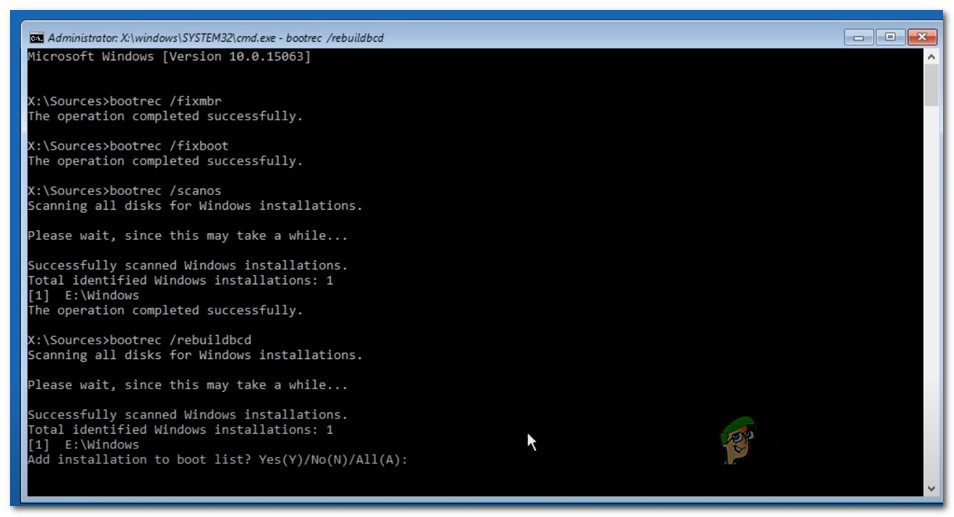
Once the commands have been executed, boot your PC normally and check if the issue is resolved.
4. Re-register Windows Installer service
It is possible for Windows Installer files and registry entries to become damaged or corrupted over time, resulting in the service malfunctioning or not starting. If you re-register the Windows Installer service, you can resolve any issues with the Windows Installer by repairing corrupt or missing files that are interfering with the Windows Installer’s operation.
Re-registering the Windows Installer service involves unregistering the service, deleting its associated registry keys, and then re-registering it using a command prompt. This process effectively resets the Windows Installer service to its default settings, which can fix any issues caused by corrupted files or registry entries.
Follow these steps to proceed:
- Press the Win + R keys together to open a Run dialog.
- Type cmd in the text field of Run and click Ctrl + Shift + Enter to open Command Prompt with administrative privileges.
- Click Yes in the User Account Control prompt.
- Once you are in the Command Prompt, type the commands below one by one and hit Enter.
%windir%\system32\msiexec.exe /unregister
%windir%\system32\msiexec.exe /regserver
%windir%\syswow64\msiexec.exe /unregister
%windir%\syswow64\msiexec.exe /regserver
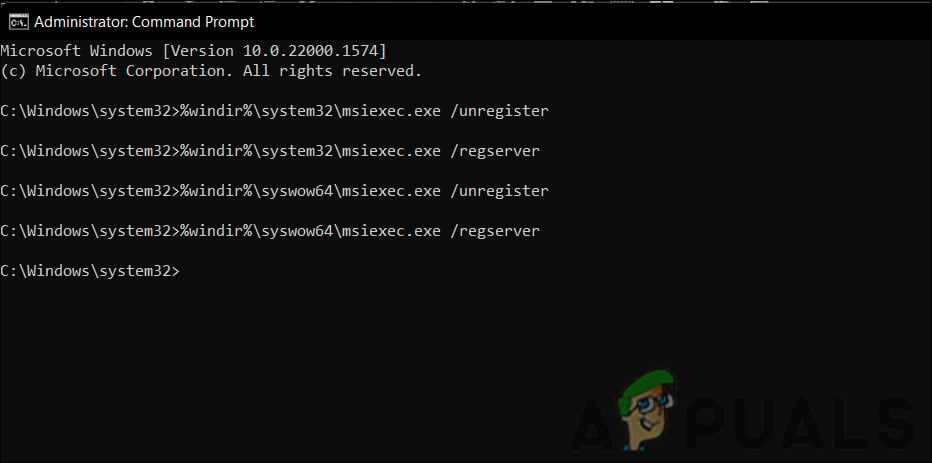
Once the commands are executed, close the Command Prompt window and restart your computer. Hopefully, upon reboot, you will be able to use the Windows Installer without any problems.
5. Use the Program Install and Uninstall Troubleshooter
Using the Program Install and Uninstall troubleshooter can potentially fix issues with the Windows Installer by identifying and resolving problems with specific installations or uninstallations. In Windows, this troubleshooter is a built-in tool that diagnoses and fixes problems with Windows Installer, including failed installations, errors, and other problems.
When you run the Program Install and Uninstall troubleshooter, it scans your system for any installed programs or updates that may be causing issues with the Windows Installer and then attempts to repair or remove these programs as necessary. In this way, conflicts or compatibility issues between programs and the Windows Installer will be addressed, resolving the error in the process.
Here is how you can proceed:
- Navigate to Program Troubleshooter’s download page and download the troubleshooter.
- Click on the file you just downloaded to launch it.
- Hit Next and choose Installing.

Click on Installing - You can now choose the application that you want to install from the list available. If it is not listed there, choose Not listed.

Choose the program - Wait for the troubleshooter to identify any issues and proceed with the installation.
6. Update the Windows Installer
Incompatible or outdated versions of the Windows Installer can cause problems with the installer’s functionality, resulting in unsuccessful installations and updates.
To resolve issues caused by an outdated or incompatible Windows Installer, you can try updating to the latest version of the installer, which can be downloaded from the Microsoft website. Alternatively, if the installer isn’t updating, you can try installing or updating a compatible version of the software, which may be available on the software developer’s website or support forums.
A Windows Installer update could potentially fix any compatibility issues and make the installer compatible with the latest updates and software.





